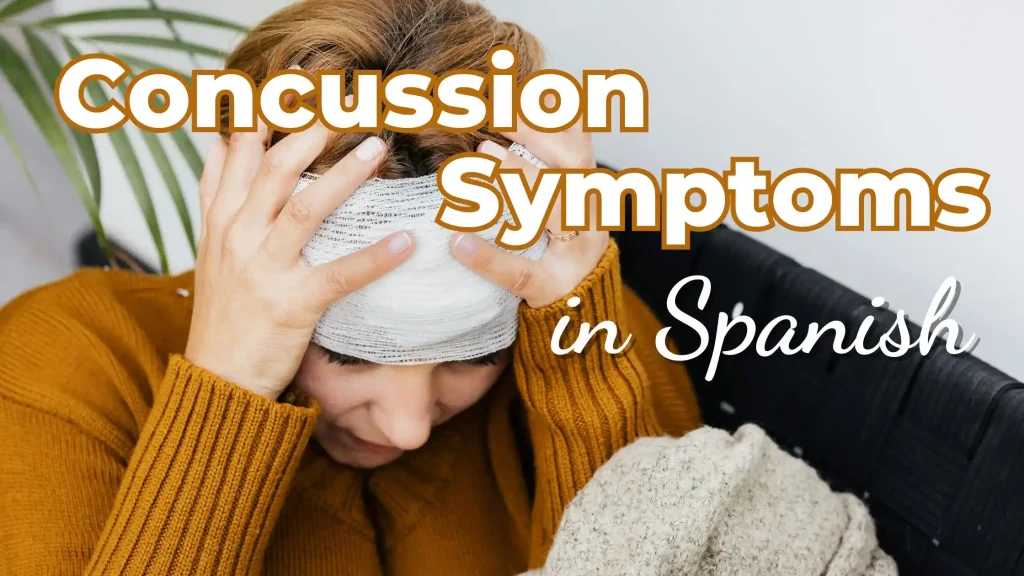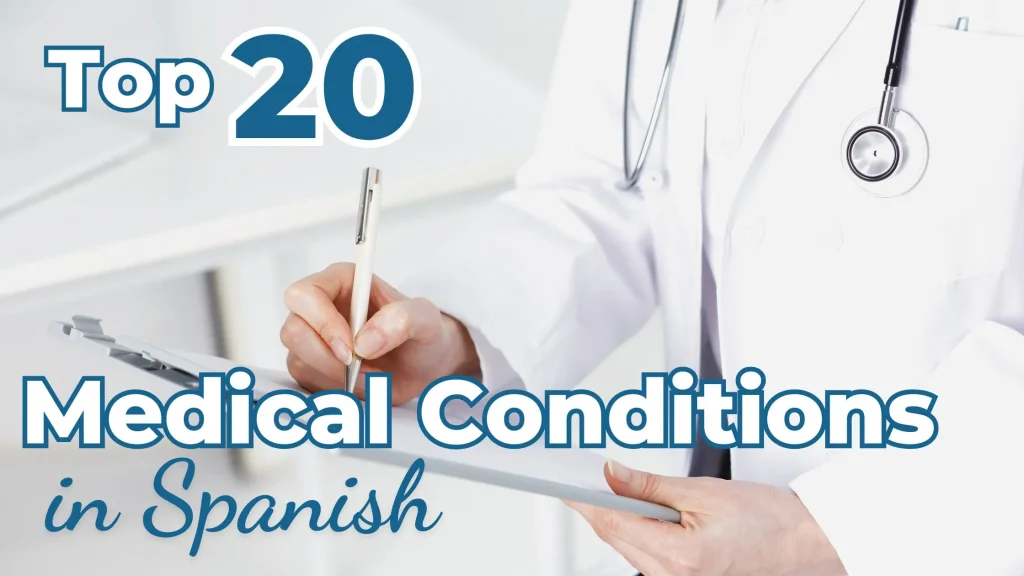This Medical Spanish lesson focuses on talking about and evaluating chest pain in Spanish: el dolor de pecho.
Here is the Medical Spanish lesson I taught to the Facebook group:
Subscribe to our YouTube Channel to see all of our lessons and get the latest videos right away!
Let’s start the lesson learning some anatomy related to chest pain:
| Spanish | English |
| El pecho | Chest |
| Los pechos | Breasts |
| Los senos | Breasts |
| Las costillas | Ribs |
| La clavícula | Clavicle |
| El estómago | Stomach |
| El hígado | Liver |
| La vesícula biliar | Gallbladder |
| Los pulmones | Lungs |
| Los bronquios | Bronchi |
| El esternón | Sternum |
| La traquea | Trachea |
Note: In the past, we talked about the pain in Spanish and the different words to talk about it. So be sure to take a look to this post as well 🙂
Signos y síntomas básicos / Basic Signs and Symptoms
We need to define some basic signs and symptoms from the beginning, that way it will be easier for you to understand the history of the chest problem.
| Spanish | English |
| Ansiedad | Anxiety |
| Ardor | Burning sensation |
| Crepitación – sonidos / respiraciones crepitantes | Crackling sounds in breathing / crepitus |
| Debilidad | Weakness |
| Dificultad para respirar | Difficulty breathing |
| Dolor agudo | Sharp pain |
| Dolor ardiente | Burning pain |
| Dolor con movimientos específicos | Pain with specific movements |
| Dolor con/sin presión | Pain with / without pressure |
| Dolor después de comer | Pain after eating |
| Dolor que corre al lado izquierdo (el cuello, el brazo) | Pain that runs on the left side (neck, arm) |
| Edema (hinchazón) | Swelling |
| Falta de aire | Shortness of breath |
| Fiebre | Fever |
| Jadeos | Gasping |
| Mareos | Dizziness |
| Miedo | Fear |
| Nausea | Nausea |
| Palpitaciones | Palpitations |
| Piel húmeda | Wet skin |
| Presión alta, baja | High / low blood pressure |
| Presión en el pecho – pecho apretado | Pressure in the chest – tight chest |
| Sudores Silbidos – Sibilancia – Resuello | Sweating Wheezing |
| Tos fuerte con flema | Hard cough with phlegm |
| Tos con sangre | Bloody cough |
| Vómito (con sangre) | Vomiting (with blood) |
Common Causes of Chest Pain / Causas comunes del dolor de pecho
Now it’s time to review the most common causes of chest pain and their symptoms.
1. Asma / Asthma
| Spanish | English |
| Una inflamación y restricción de las vías respiratorias. | An inflammation and restriction of the airways. |
| Resulta en falta de aire, sibilancia, dificultad para respirar, ansiedad. | It results in lack of air, wheezing, difficulty in breathing, anxiety. |
| Es fácil de controlar con un inhalador. | It is easy to control with an inhaler. |
2. Ataque de corazón (infarto) / Heart Attack
| Spanish | English |
| Cuando hay una restricción o un bloqueo del flujo de sangre a los músculos del corazón y no recibe suficiente sangre oxigenada. | When there is a restriction or blockage of blood flow to the heart muscles and it does not receive enough oxygenated blood. |
| Es una emergencia. | It’s an emergency. |
| Los síntomas incluyen: nausea, vómito, falta de aire, debilidad, presión en el pecho, sudores, dolor que corre al lado izquierdo. | Symptoms include: nausea, vomiting, shortness of breath, weakness, pressure in the chest, sweating, pain that shoots to the left side. |
3. Ataque de pánico / Panic Attack
| Spanish | English |
| Es un miedo intenso y repentino en que siente que está sufriendo un ataque al corazón, que se vuelve loco y/o que va a morir. | It is an intense and sudden fear that you are suffering from a heart attack, that you maybe going crazy and / or that you are going to die. |
| Uno siente palpitaciones, falta de aire, ansiedad, temblores, mareo, respiraciones rápidas. | You feel palpitations, shortness of breath, anxiety, shakiness, dizziness, fast breathing. |
4. Acedía (reflujos, ácidos, agruras) / Acid (reflux, heartburn)
| Spanish | English |
| Cuando ácidos estomacales suben del estómago hacia arriba en la garganta. | When stomach acids rise from the stomach up into the throat. |
| Resulta en ardor y dolor, cólicos y se siente hinchado | It results in burning and pain, stomach cramping and you feel bloated |
5. Bronquitis / bronchitis
| Spanish | English |
| Es una infección en las vías respiratorias. | It is an infection in the airways. |
| Se inflaman y restringen el flujo de aire. | They inflame and restrict airflow. |
| Puede ser causado por virus o bacteria. | It could be caused by viruses or bacteria. |
| Resulta en dificultad para respirar, tos con flema, jadeo y presión en el pecho | It results in difficulty breathing, productive cough, gasping and chest pressure |
6. Coágulo en el pulmón (embolia) / Clot in the lung (embolism)
| Spanish | English |
| Cuando un coágulo en la sangre se le sube al pulmón y obstruye el flujo de sangre o bloquea una arteria que alimenta al pulmón. | When a blood cot goes up to the lung and obstructs the blood flow or blocks an artery that’s feeding the lung |
| Resulta en dificultad para respirar, falta de aire, mareos y ritmo cardíaco irregular. | It results in difficulty breathing, shortness of breath, dizziness and irregular heartbeat. |
7. Fractura de costilla / Rib Fracture
| Spanish | English |
| Las costillas son huesos delgados. | The ribs are thin bones. |
| Después de un trauma al pecho o al costado es posible fracturar una costilla. | After a chest or trauma to your side it is possible to fracture a rib. |
| Resulta en dolor de pecho, dolor al respirar y dolor al palpar el área afectado. | It results in chest pain, pain when breathing and pain when you touch the affected area |
8. Neumotórax / Pneumothorax
| Spanish | English |
| Es cuando hay un agujero o perforación u otro tipo de lesión al pulmón que resulta en un colapso pulmonar. | It is when there is a hole or perforation or other type of injury to the lung that results in a lung collapse. |
| Resulta en dolor de pecho, dificultad para respirar. | It results in chest pain, difficulty breathing. |
9. Neumonía – Pulmonía / Pneumonia
| Spanish | English |
| Neumonía es una infección en los pulmones causada por bacteria, virus o hongos. | Pneumonia is an infection in the lungs caused by bacteria, viruses or fungi. |
| Resulta en fiebre alta, escalofríos, tos con flema y dolor al respirar. | It results in high fever, chills, productive cough and pain when breathing. |
Historia del problema / History of the Problem
We talked about how to take the medical history in the past, but let’s do a quick review to these concepts and some useful questions you can ask to your Latino patients:
- ¿Cuándo comenzó el dolor?: When did the pain start?
- ¿Cuándo está peor? ¿Mejor?: When is it worst? When is it better?
- How did it start?: ¿Cómo empezó?
- Suddenly?: ¿De repente?
- Little by little?: ¿Poco a poco?
- ¿Qué hacía cuando empezó?: What did you do when it started?
- ¿Ha tenido este dolor antes?: Have you had this pain before?
- ¿Le duele cuando… Do you have pain when you…
- camina?: walk?
- hace ejercicio?: do exercise?
- se esfuerza?: strain?
- se acuesta?: lie down?
- descansa?: are resting?
- respira?: are breathing?
Remember, here is a full post about how to use OLDCARTS in Spanish
Exámenes y procedimientos / Tests and Procedures
Here is a short list of tests and procedures you could recommend to your Latino patient to make a better diagnose for the chest pain:
| Spanish | English |
| Para diagnosticar: | To diagnose: |
| Análisis de sangre y laboratorios | Blood tests and labs |
| Electrocardiograma (ECG) | Electrocardiogram (ECG) |
| Endoscopia: un tubo con cámara para ver la garganta y el estómago | Endoscopy: a tube with a camera to see the throat and stomach |
| Examen físico, signos vitales, y examen de estrés | Physical exam, vital signs, and stress test |
| Nitroglicerina para ver si se alivia | Nitroglycerin to see if it any of the symptoms are relieved |
| Rayos equis, Radiografía del pecho | X rays, chest X-ray |
| Tomografía computada (TAC) | Computed tomography (CT scan) |
| Ultrasonido: Sonografía para ver los órganos, los vasos sanguíneos y otros tejidos | Ultrasound: Sonography to see organs, blood vessels and other tissues |
PD: Two Updates for you! / ¡Dos noticias!
1. Immersion Programs: this is the best way for you to gain comfort, confidence, and fluidity in your expression in Spanish. If interested, check our Medical Immersion Programs.
Now is your turn! ¡Ahora te toca a ti!
Study these chest pain in Spanish vocabulary with the flashcards below:
Download the lesson notes and start creating your own questions and phrases using this new vocabulary in Spanish and share it on the comments below or in our Facebook group to receive feedback from other Medical Spanish learners
I packaged all of this into easily downloadable .pdf notes– Get your copy for free today!
Keep up the good work speaking responsible Spanish to your patients! Check out our other books, classes & products to help you !
*If the link isn’t working for you, you may need to unblock pop-ups in your browser settings






